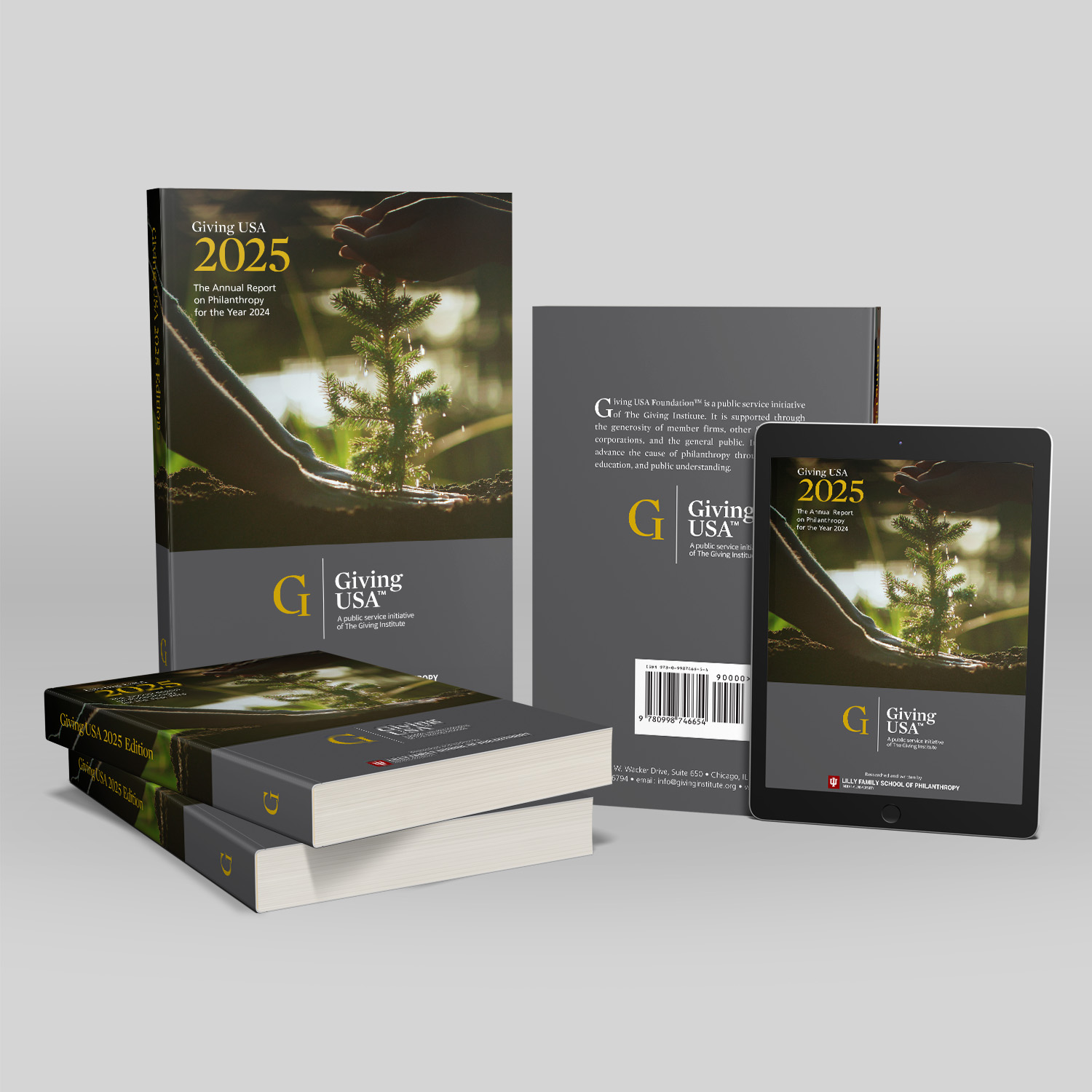
5 Strategies to Implement Based on Giving USA 2023
By Joshua Meyer, VP of Demand Generation for Bloomerang
The Giving USA 2023 report highlighted the challenging economic circumstances of 2022 and nonprofit sector trends in the aftermath of the global pandemic. After two years of record-breaking giving inspired by the pandemic, overall giving declined by 10.5% (after adjusting for inflation) in 2022.
In this post, we highlight five key takeaways from the Giving USA 2023 report and other relevant industry reports to paint a full picture of the current state of philanthropy. We’ll also explore strategies and techniques your organization can use to future-proof your fundraising approach and adapt to current trends.
1. Individual giving declined in 2022
From the Giving USA 2023 report: “Giving by individuals totaled an estimated $319.04 billion, declining 6.4 percent in 2022 (a decline of 13.4 percent, when adjusted for inflation).”
Inflation, stock market volatility, and stagnation of disposable personal income all created a challenging economic environment for individuals in 2022, contributing to a decrease in individual giving. This decline also comes on the heels of unprecedented giving inspired by the pandemic, and overall giving in 2022 reflected pre-pandemic levels. Total giving is still driven largely by individuals, comprising 64% of contributions.
What this means for your nonprofit’s strategy: Donor retention continues to be crucial for nonprofit fundraising success. Maintaining relationships with your nonprofit’s current donors can help weather any declines in individual giving.
The importance of individual giving means that your donor stewardship approach should be tailored to each supporter. Personalize your donor messages, whether on online channels like email and text or traditional methods like direct mail. Address messages with each donor’s name and reference past interactions they’ve had with your organization. Go above and beyond by asking why they give to your organization or which programs resonate with them and use that information to tailor your outreach further.
Store information about your donor conversations in your donor management and online fundraising platform to build on past interactions and develop meaningful, genuine connections.
2. Major gift amounts are growing tremendously
From the report: “In some years, particular individuals make very large gifts, called ‘mega-gifts,’ to charitable organizations. Giving USA 2023 includes a conservative estimate of $13.96 billion for gifts of this magnitude that were likely paid by individuals in 2022.”
These mega-gifts represent about 5% of individual giving for the second year in a row. Major gifts by billionaires such as Bill Gates, MacKenzie Scott, and Elon Musk topped the list of these mega-gifts.
What this means for your nonprofit’s strategy: Your nonprofit likely isn’t expecting a donation from one of these billionaires. Nevertheless, it’s still important to be aware of the impact of the ultra-wealthy on your donor pipeline.
It’s also essential to avoid overreliance on major donors. Let’s say an organization depends on a yearly multi-million-dollar donation from a single donor in your community. If that donor decides to stop giving for any reason, that nonprofit could be looking at a major crisis for keeping its activities running. Diversifying your fundraising is one key to managing a healthy nonprofit.
Maintain a resilient and balanced major gift approach with these tips:
- Build long-lasting major donor relationships. Bloomerang’s major gift guide recommends hosting small-group gatherings, asking donors for their feedback, and setting up one-on-one meetings with major donors.
- Focus on developing a donor pipeline that reaches donors at all different levels. Don’t overlook your mid-tier and smaller donors as you build your donor stewardship approach. For example, you might call donors at all levels to thank them for their gifts or create a digital donor wall that lists all donors’ names for a certain campaign.
- Update your fundraising software as needed to better reach your donor stewardship goals. Your fundraising software and donor management system should allow you to establish a communications cadence and track donor interactions and donation histories, empowering your organization to continue growing.
Major gifts will always be essential to nonprofit funding, but these strategies allow you to balance your major gift acquisition with efforts to build strong relationships with all donors.
3. Mobile and desktop devices are important awareness and fundraising channels
From the M+R Benchmarks 2023 report: “The majority of nonprofit website traffic came from users on mobile devices — 57%, with 43% of traffic from users on desktop devices. However, 75% of revenue came from users on desktop devices.”
According to the report, average online revenue dropped by 4% last year, also reflecting the return to the norm that the sector is facing.
What this means for your nonprofit’s strategy: Engaging with audience members through online platforms such as email, social media, your website, and text messaging is an effective way to promote awareness of your mission and boost donations.
Supporters may access these channels on their mobile devices to learn more about your nonprofit’s cause. However, the data shows that most online revenue comes from desktops. That means it’s important to create online content that’s responsive and readable on every device.
Use your website’s content management system (CMS) to ensure that your site is mobile-friendly and accessible to all audience members, with large, legible fonts, contrasting colors, and other accessibility considerations that improve readability.
4. Subsector giving continues to respond to external circumstances
From the Giving USA 2023 report: “Giving to international affairs is estimated to be $33.71 billion in 2022, staying level with 2021 with 10.9 percent growth. Adjusted for inflation, giving to international affairs organizations grew by 2.7 percent.”
The Giving USA report assesses donations by organization type, including categories such as religion, health, education, human services, and more. Giving to international affairs organizations in particular saw a significant boost in 2022, likely due to the media attention surrounding Russia’s invasion of Ukraine. Giving to international affairs organizations and foundations were the only two subsectors to see positive growth (when adjusted for inflation).
What this means for your nonprofit’s strategy: Update your SWOT analysis based on evolving external factors. This analysis involves reviewing your nonprofit’s strengths, weaknesses, opportunities, and threats. Pay special attention to your opportunities and threats, as these are impacted by external factors that your nonprofit will have to respond to.
Successful future giving will depend on your nonprofit’s ability to communicate to its donors how they can be a part of the solution to combat these challenges. Experts recommend using your online donation page to convey the impact of donations on your mission. For example, you might say “Amid the ongoing hunger crisis in our community, your support is needed now more than ever. A $50 donation can help feed a family of four for a week.”
5. Donor-advised funds are growing quickly
From The 2022 DAF Report: “DAF donors were highly active in 2021… Grants from DAFs to qualified charities totaled an estimated $45.74 billion, representing a 28.2 percent increase compared to 2020, which itself was 28.3 percent higher than in 2019.”
Donor-advised funds (DAFs) are charitable giving accounts that are typically eligible for immediate tax deductions. Donors can use these accounts to recommend grants to public charities.
DAFs offer donors flexibility and versatility, making them a popular donation option.
What this means for your nonprofit’s strategy: Because of the growing popularity of DAFs among donors, your nonprofit must understand how these gifts work to effectively accept and manage them at your organization.
Here are a few tips to manage DAFs effectively:
- Acknowledge these types of donations properly. Recognize both the organization that sponsored the DAF and the donor themselves.
- Let donors know how they can make an immediate impact with their funds. One of the downsides to DAFs is that donations can be delayed, and funds end up sitting in DAF accounts. Inform donors about the instant impact they can make by donating a regular charitable gift or contributing now using their DAF.
- Use DAFs to identify potential major donors. Donors who use DAFs are often good major donor prospects. Keep track of which supporters have DAFs and add them to your major donor cultivation process.
- Explore giving software that makes it easy for donors to give via a DAF. Certain software tools make it easy to remind donors to contribute their DAF funds rather than letting them remain unused. For example, Infinite Giving’s DAF software allows you to add a widget to your website or giving page that directs donors to the information they need to start contributing through their DAFs.
Modern giving avenues like DAFs, crypto donations, and gifts of stock are becoming more popular for donors, so your nonprofit should be prepared to accept these gifts.
Although overall giving declined in 2022, that doesn’t spell disaster for the nonprofit sector. Multiple subsectors are experiencing two-year growth overall, and the record-breaking highs of the pandemic era of giving were bound to return to normalcy.
As you review reports like Giving USA and other recent studies, continue to consider how your nonprofit can adapt to current trends and circumstances to position itself for future growth.


